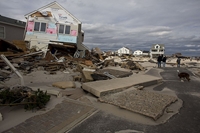Summer may not be officially in full swing until June 21, but the start of hurricane season is considered a sign of a warmer Atlantic Ocean, Gulf Coast and Caribbean Sea. Between June 1 through November 30, communities and states along the coasts of these bodies of water will have to be on the lookout for strong winds, thunderstorms and surging tides, but will they spend most of the season just watching and waiting?
Predictions from multiple weather tracking services like the National Oceanic Atmospheric Administration, Coastal Carolina University and AccuWeather indicate that the 2014 hurricane season will be extremely mild, with nine to 11 named tropical storms and one or two major storms.
These findings are due to the fact that the Pacific Ocean will experience an El Niño jet stream, one that will include strong wind shears "that can tear developing Atlantic hurricanes apart," USA Today reported.
"If we have a robust El Niño develop, then the numbers will be much lower and this could be one of the least active years in memory," AccuWeather meteorologist Dan Kottlowski told the source.
As May and National Hurricane Preparedness Week comes to a close, it is important that business owners have a business continuity plan in place this summer and fall. Despite a quiet forecast, it only takes one weather event to cause widespread damage, even if the property is miles from the coast, Nora Hahn of SungardAS explained. Hahn believes that no town is truly safe because a single storm can cause a lot problems.
A common mistake governments and organizations make is that they look at the system's wind strength to determine if the tropical storm or hurricane will cause local flooding or property damage. A stronger determining factor is seeing what the local tide is when the storm is estimated to arrive — if it occurs during high tide, expect a powerful storm surge to follow. Some of the damages from Hurricanes Katrina and Sandy were the result of a storm surge, the Property Casualty Insurers Association of America added.
If companies plan on purchasing flood insurance or other protections this hurricane season, they must be aware that there is typically a 30-day grace period before the policy goes into effect. This means that waiting for a storm to actually damage the building can make maintaining business continuity that much harder.
Despite the predictions, don't wait for the last minute to make necessary changes. Business continuity consultants can provide advice in preparing for a storm and evacuating the premises.

